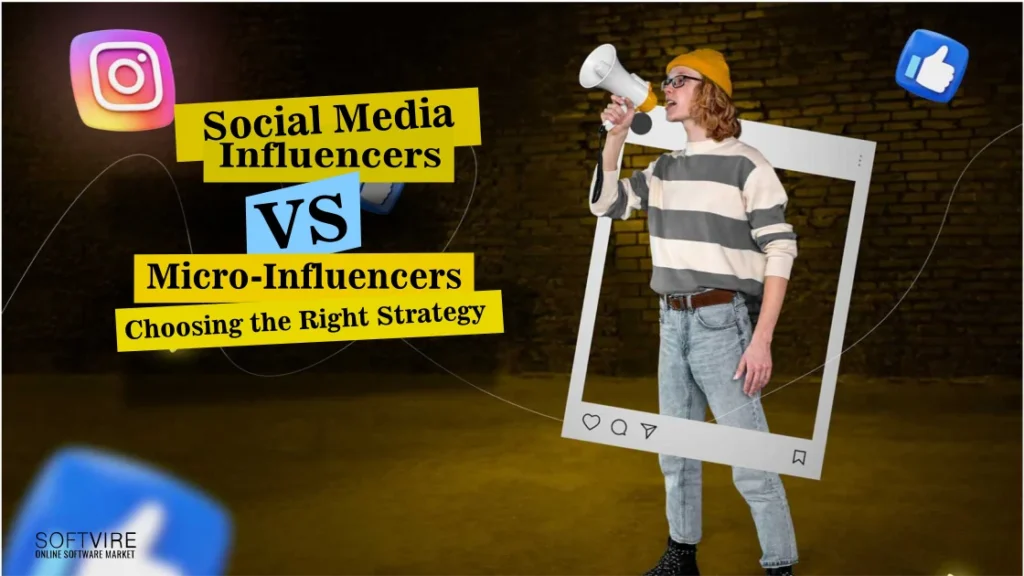Influencer marketing has become an essential component of digital marketing strategies. It allows brands to leverage social media influencers’ reach, credibility, and influence to promote their products or services. Influencer marketing enables brands to access highly engaged and targeted audiences, increase brand awareness, and drive customer engagement and conversions.
Being an influencer nowadays has become a viable means of income online and an affordable way for businesses to promote their products via collaborative work. But what kind of influencer gets more traction online? Social media influencers or micro-influencers? Let’s find out in this article.
A Brief Background on Social Media Influencers
Social media influencers have established a significant following and influence on various platforms. They create content, share their experiences, and engage with followers, often in specific niches or industries. Influencers can shape opinions, inspire trends, and influence purchasing decisions of their followers.
This means they possess the expertise, credibility, and unique personality that resonates with their audience. In this way, brands can collaborate with them and entrust engagement with their followers, establishing a relationship of trust and authenticity.
Types of Social Media Influencers
There are different types of social media influencers available today, and these are the following:
-
Macro or Celebrity Influencers
Macro influencers have a large following on social media platforms, often in the millions. They may include celebrities, athletes, or famous figures from various industries. These influencers have a wide reach and can provide exposure to a broad audience.
-
Micro-influencers
Micro-influencers have a more minor but highly engaged following, typically ranging from a few thousand to a hundred thousand followers. They are often experts or enthusiasts in specific niches or industries. Micro-influencers have a more targeted and loyal audience, allowing for deeper connections and higher levels of engagement.
Difference Between Macro and Micro-Influencers
When choosing an influencer strategy, it’s essential to consider the differences between macro-influencers and micro-influencers.
-
Reach and Audience Size
Macro-influencers have a broad reach and access to a larger audience and can help brands gain exposure to many followers and increase brand visibility on a broader scale. On the other hand, micro-influencers have a more niche reach, catering to a smaller and more specific audience. While their reach may be smaller, they often have a dedicated and highly engaged following within their niche.
-
Engagement and Authenticity
Macro-influencers may have lower engagement rates than micro-influencers due to their audience size. They may still have significant influence and impact due to celebrity status or expertise in a particular field. However, maintaining authenticity and a genuine connection with their audience can sometimes be challenging.
Meanwhile, micro-influencers tend to have higher engagement rates as they have a more personal connection with their audience. Their followers often perceive them as relatable and trustworthy, which enhances the authenticity of their content and recommendations.
-
Cost and Budget Considerations
Collaborating with macro-influencers usually requires a higher budget as they command higher fees or compensation for their reach and influence. Brands need to allocate more resources to work with macro-influencers. On the other hand, micro-influencers generally charge lower fees or may even collaborate in exchange for products or services. They provide a more budget-friendly option for brands, especially those with limited marketing budgets.
-
Niche Expertise and Target Audience Alignment
Macro-influencers may have a broader appeal and a more diverse audience base. While this can be advantageous for reaching a wide range of potential customers, it may result in a misalignment with a specific target audience or niche market.
Meanwhile, micro-influencers typically have niche expertise and a more focused audience. Their content caters to a specific interest or industry, allowing for better alignment with a brand’s target audience. This targeted approach can result in more effective and relevant messaging.
Choosing the Right Influencer Strategy
Several factors should be considered when selecting an influencer strategy to ensure the best fit for your campaign objectives and target audience.
-
Defining Campaign Objectives and Target Audience
Clearly define the goals and objectives of your influencer campaign. Determine your desired outcomes, such as increasing brand awareness, driving website traffic, or generating sales. Understand your target audience demographics, preferences, and behaviors to identify the type of influencer that can effectively reach and resonate with them.
-
Evaluating the Marketing Goals and Budget Limitations
Consider your marketing goals and budget constraints. Determine how much you can allocate to influencer marketing and whether it aligns with the expected ROI. Evaluate the potential impact and reach of macro-influencers versus the cost-effectiveness and engagement potential.
-
Assessing the Suitability of Macro-Influencers or Micro-Influencers
Analyze the fit between your brand and the influencer’s audience, values, and content. Macro-influencers may be suitable for broader brand exposure and reaching a wide audience. Micro-influencers may be better if you seek niche expertise and more personalized connections.
-
Considering the Authenticity and Engagement Factor
Authenticity and engagement are crucial aspects of influencer marketing. Assess the authenticity and genuine connection between the influencer and their audience. Evaluate the engagement rates and interactions on their posts to gauge the impact and potential influence they have.
-
Collaborating with Influencers and Negotiating Partnerships
Once you have identified potential influencers, contact them to discuss collaboration opportunities. Communicate your campaign objectives, expectations, and deliverables. Negotiate the terms of the partnership, including compensation, content guidelines, disclosure requirements, and exclusivity agreements.
Best Practices for Influencer Marketing
To maximize the effectiveness of influencer marketing campaigns, adhere to these best practices:
-
Conducting Thorough Influencer Research and Vetting
Research and evaluate potential influencers based on their content quality, engagement levels, audience demographics, and alignment with your brand values. Vetting influencers ensures they align with your campaign objectives and target audience.
-
Building Authentic Relationships with Influencers
Focus on building genuine relationships with influencers based on mutual trust and shared values. Engage in ongoing communication, provide support, and collaborate closely to ensure a successful partnership.
-
Clearly Defining Campaign Goals and Expectations
Communicate your campaign goals, objectives, and deliverables to influencers. Provide detailed guidelines for content creation, product/service promotion, and brand messaging to ensure consistency and alignment with your brand image.
-
Monitoring and Measuring Campaign Performance
Continuously monitor and measure the performance of influencer campaigns. Track key performance indicators (KPIs) such as reach, engagement, click-through rates, conversions, and return on investment (ROI). Use analytics tools to gather data and insights for optimization and future decision-making.
-
Complying with Legal and Ethical Guidelines
Ensure compliance with legal and ethical guidelines when working with influencers. Familiarize yourself with relevant advertising and disclosure regulations, such as disclosing sponsored content or paid partnerships. Maintain transparency in your collaborations to build trust with your audience.
Potential Challenges and Risks to Watch Out For
Influencer marketing comes with specific challenges and risks that need to be addressed:
-
Influencer Fraud and Fake Followers
Be cautious of influencer fraud, where influencers may artificially inflate follower counts or engagement metrics. Thoroughly vet influencers and analyze their audience engagement to ensure the authenticity of their following.
-
Maintaining Control over Brand Messaging
Maintaining control over brand messaging can be challenging when collaborating with influencers. Communicate your brand guidelines and expectations to ensure the content aligns with your brand identity and values.
-
Ensuring Disclosure and Transparency
Adhere to disclosure guidelines to maintain transparency and trust with your audience. Ensure that influencers disclose sponsored content or partnerships according to regulatory requirements.
-
Dealing With Potential Influencer Controversies
Influencers may face controversies or adverse publicity that can impact your brand. Regularly monitor influencers’ online presence and address any potential issues proactively to mitigate any negative impact on your brand reputation.
Conclusion
Influencer marketing offers valuable opportunities for brands to reach and engage with their target audience. Choosing between social media influencers and micro-influencers depends on reach, engagement, authenticity, and budget considerations.
By defining campaign objectives, evaluating marketing goals, and considering the suitability of each type of influencer, brands can make informed decisions to maximize the impact of their influencer marketing strategies. Embracing best practices and addressing potential challenges will contribute to successful influencer collaborations, ultimately driving brand awareness, engagement, and conversions in the dynamic landscape of digital marketing.
Check out the different Microsoft software products today if you need trusted software that uses AI ethically and efficiently. They continue to lead in using AI for their many office tools like Office 365. Get discounted Office 365 in New Zealand now!



